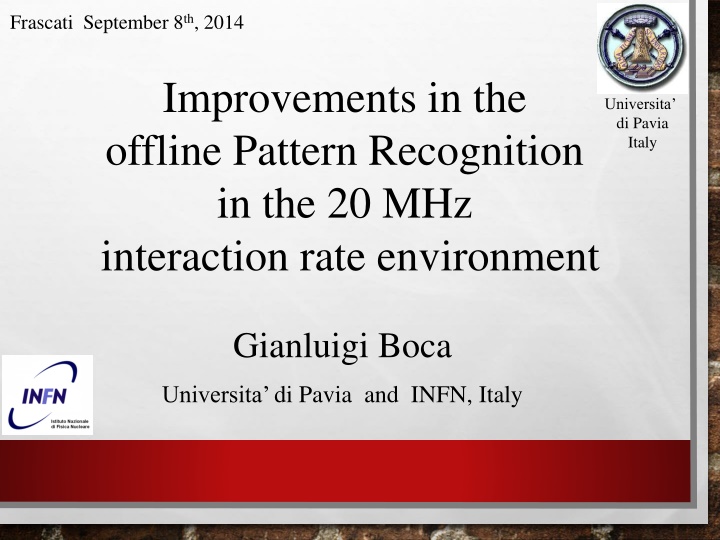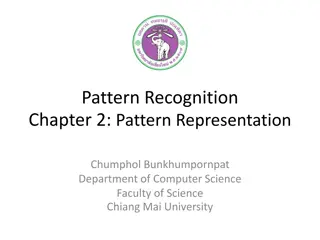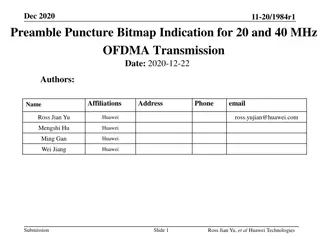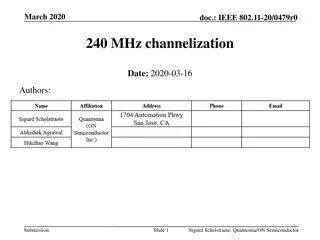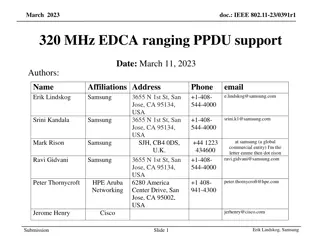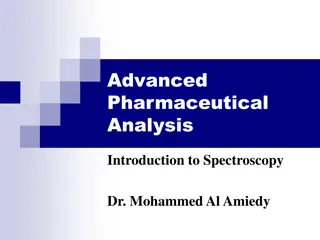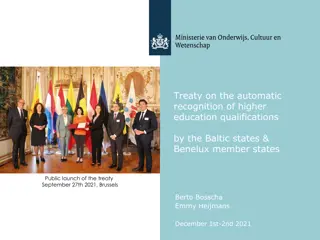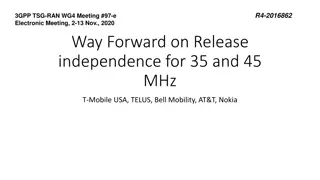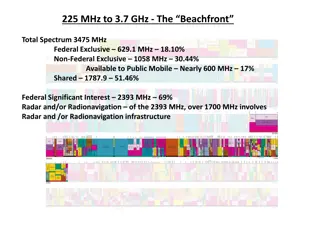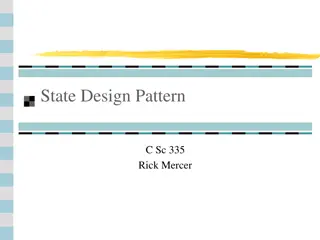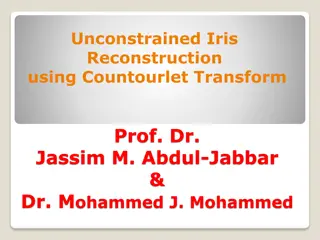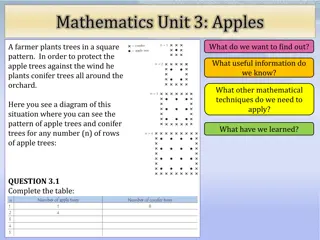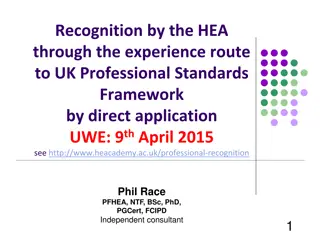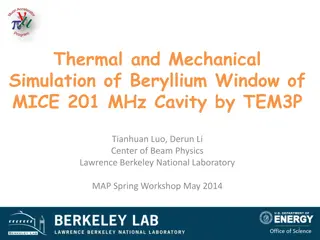Enhancements in Offline Pattern Recognition at 20 MHz Rate
The talk delves into improving pattern recognition code in a high interaction rate environment, focusing on combatting negative effects of pileup events and outlining significant changes made for better efficiency in track reconstruction.
Download Presentation

Please find below an Image/Link to download the presentation.
The content on the website is provided AS IS for your information and personal use only. It may not be sold, licensed, or shared on other websites without obtaining consent from the author.If you encounter any issues during the download, it is possible that the publisher has removed the file from their server.
You are allowed to download the files provided on this website for personal or commercial use, subject to the condition that they are used lawfully. All files are the property of their respective owners.
The content on the website is provided AS IS for your information and personal use only. It may not be sold, licensed, or shared on other websites without obtaining consent from the author.
E N D
Presentation Transcript
Frascati September 8th, 2014 Improvements in the offline Pattern Recognition in the 20 MHz interaction rate environment Universita di Pavia Italy Gianluigi Boca Universita di Pavia and INFN, Italy
Outlook of the talk Efficiency of the Pattern recognition code with the use of both a road finding and a Hough transform algorithms has been shown to be satisfactory many times in the past in the ideal situation when no pileup caused by the 20 MHz interaction rate. Since basically last March I have been working in improving the code performances in the pileup situation. In fact initially the efficiencies were much worse because of the extra spurious hits present from background DPM events. In the following I will sketch schematically the modifications to the code and the performances. G.Boca U. Pavia & INFN, Italy
Fighting the negative effect of pileup DPM events Essentially two negative effects : 1) the efficiency of finding all true hits belonging to a track decreases and the presence of spurious hits increases; 2) many ghost tracks found. Today I will concentrate on the first point. As far as the ghost tracks are concerned I already wrote a class time ago (the Cleanup procedures) and I will perfection them after point 1) has been finished. G.Boca U. Pavia & INFN, Italy
Most important changes in the Pattern Recognition code since last collaboration meeting XY plane fit procedure : - add another iteration after first Mvd hits association and fit; - change Mvd and Stt axial hits error in conformal space fit; - Sci Til hits association criterion a bit looser now (1.5 cm); - now any axial Stt hit can belong to more than a track; (arbitration later will take care of possible ghost tracks); - fix a couple of bugs; Z space fit procedure : - maximum allowed distance of Mvd hits from trajectory in Z space set to 1.5 cm; set Skew error to 0.5 cm/sin(3 ) = 9.55; - arbitration when two Mvd hits have the same ; - try fit with a Mvd hit less (fight against spurious Mvd hits); - fix a couple of bugs; G.Boca U. Pavia & INFN, Italy
Performance : Track Reconstruction Efficiency G.Boca U. Pavia & INFN, Italy
Performance : Track Reconstruction Efficiency MC Box Generator; % of reconstructed tracks ( reconstructed track means tracks found associated to a MC truth track); Events with Background ( == pileup) at 20 MHz interaction rate P tracks per event # good gen. tracks % GeV/c rec. Tracks 0.3 1 3981 99.1 0.3 4 3986 98.8 0.3 8 3983 97.6 1.0 1 3871 99.4 1.0 4 3874 98.9 1.0 8 3892 98.5 performance excellent in efficiency ! G.Boca U. Pavia & INFN, Italy
Performance : Track Reconstruction Efficiency MC Box Generator; % of reconstructed tracks ( reconstructed track means tracks found associated to a MC truth track); Events with Background ( == pileup) at 20 MHz interaction rate P tracks per event # good gen. tracks % GeV/c rec. Tracks 2.0 1 3875 99.6 2.0 4 3858 99.4 2.0 8 3866 98.8 5.0 1 3872 99.5 5.0 4 3831 99.5 10.0 1 3886 99.5 performance excellent in efficiency ! G.Boca U. Pavia & INFN, Italy
Performance : Hit Reconstruction Efficiency G.Boca U. Pavia & INFN, Italy
A reminder : the average MC truth hit type per track P tracks per event ave. || Stt hits per track ave. Skew Stt hits per track ave. Stt hit per track ave. Pixel hits per track ave. Strip hits per track ave. Mvd hits per track GeV 0.3 1 16.7 8.2 24.9 1.8 1.9 3.7 1.0 1 15.6 7.8 23.4 1.8 1.9 3.7 2.0 1 15.9 7.8 23.7 1.8 1.9 3.7 5.0 1 15.9 7.8 23.7 1.8 1.9 3.7 10.0 1 15.9 7.8 23.7 1.8 01.9 3.7 G.Boca U. Pavia & INFN, Italy
Performance : Stt Hit Reconstruction Efficiency Excellent performance of the code even for high multiplicity events
Performance : Mvd Hit Reconstruction Efficiency Excellent performance of the code even for high multiplicity events
Performance : Spurious Hits in Reconstructed Tracks G.Boca U. Pavia & INFN, Italy
Performance : spurious Stt hits in reconstructed track Perhaps still too many spurious hits in the (surprisingly!) axial hits especially at high multiplicity
Performance : spurious Mvd hits in reconstructed track Less problems with the Mvd spurious hits
Performance : what about the cputime/track? G.Boca U. Pavia & INFN, Italy
more or less the same 5 msec/track Cpu times measured on an Intel i7-2600K CPU @ 3.4 GHz 64 bit G.Boca U. Pavia & INFN, Italy
Conclusions and future steps The efficiency of the code in finding the true hits in a track in a 20 MHz environment is very good both for Stt and Mvd hits in the central tracker. The cputime per track hasn t changed much : more or less it is the usual 5 msec/track in a conventional Cpu. A problem remains with the axial Stt spurious hit presence and hopefully I will fix it nextly. After that I will revert to the refinement of the Cleanup procedure. After that the code will be parallelized. G.Boca U. Pavia & INFN, Italy
